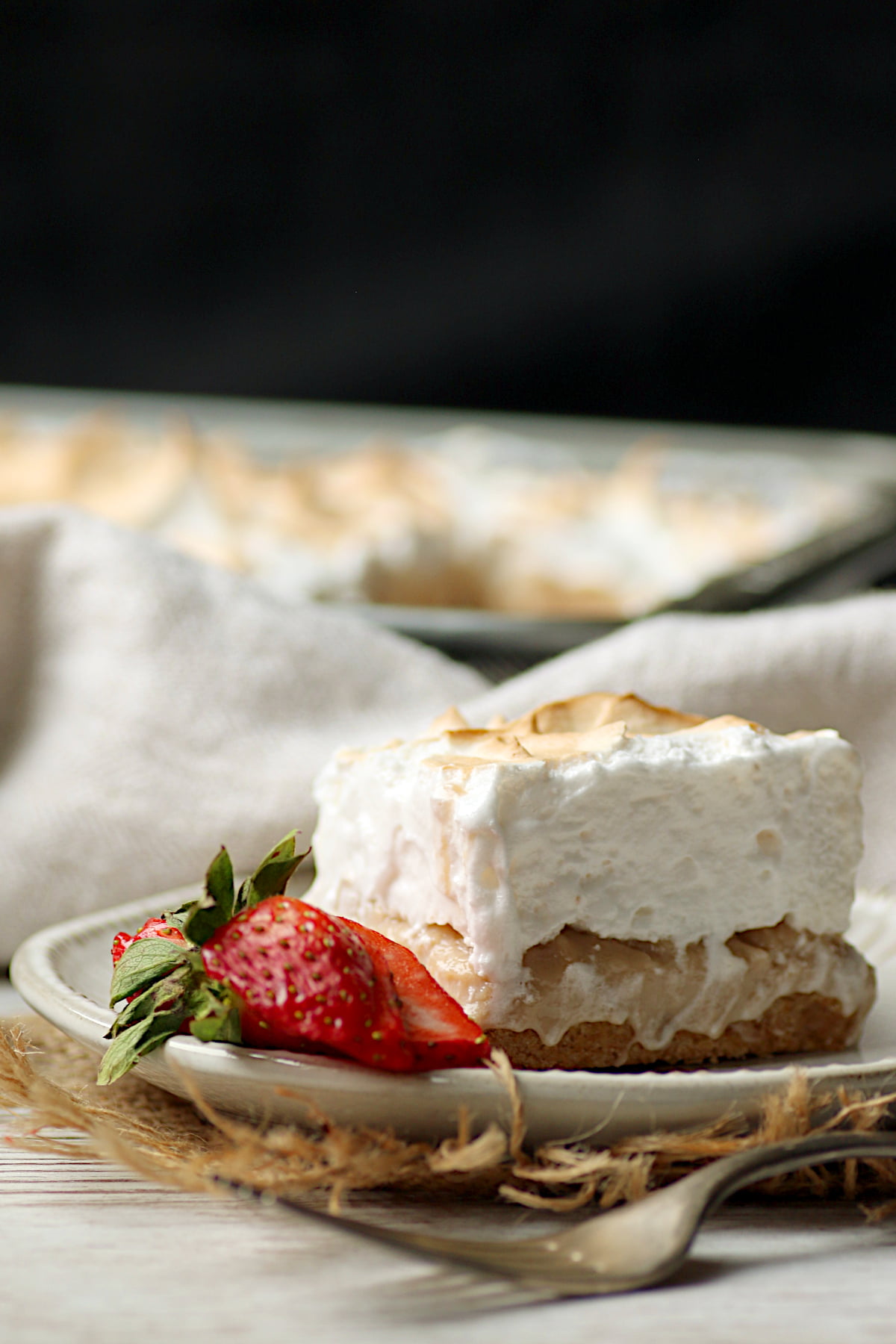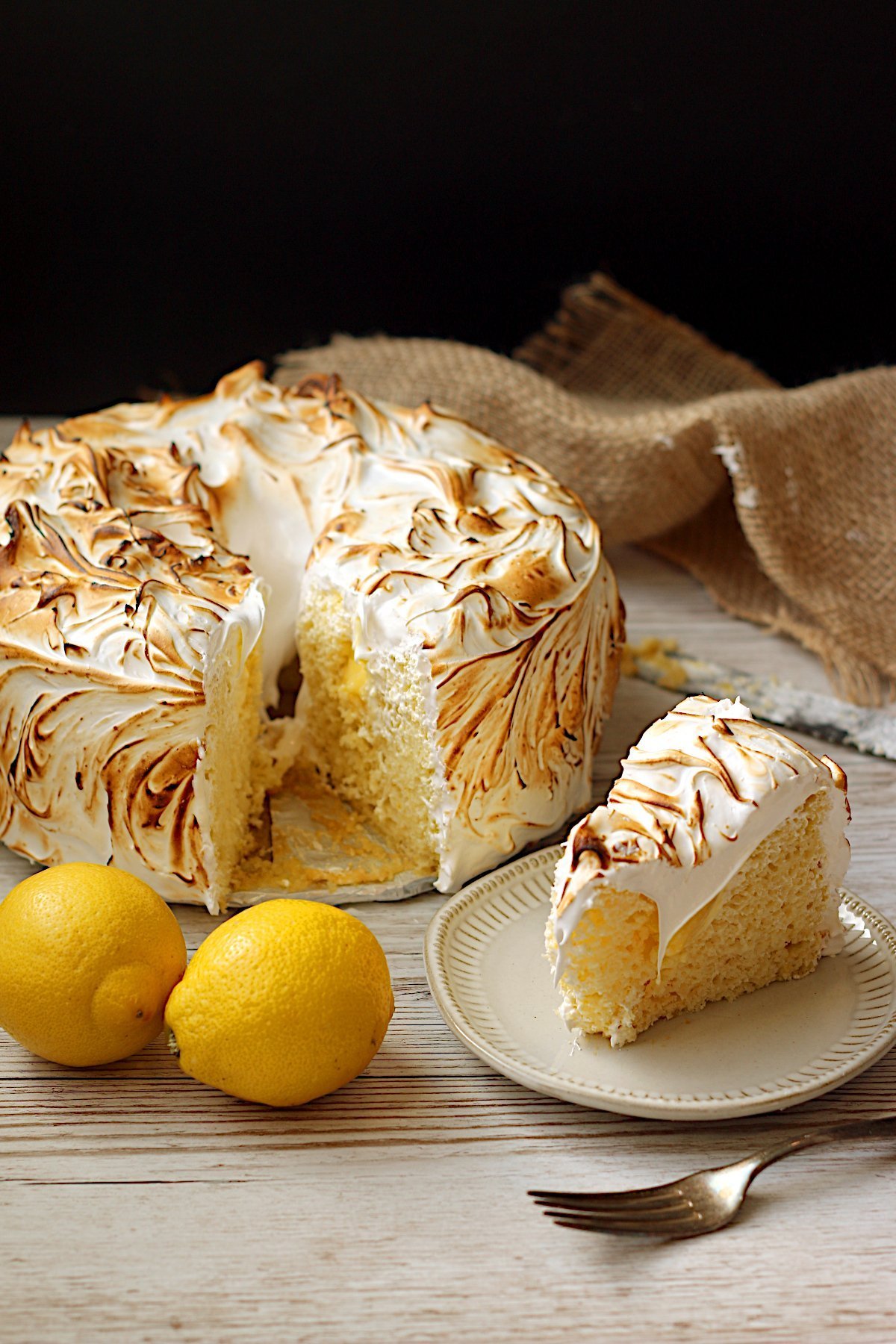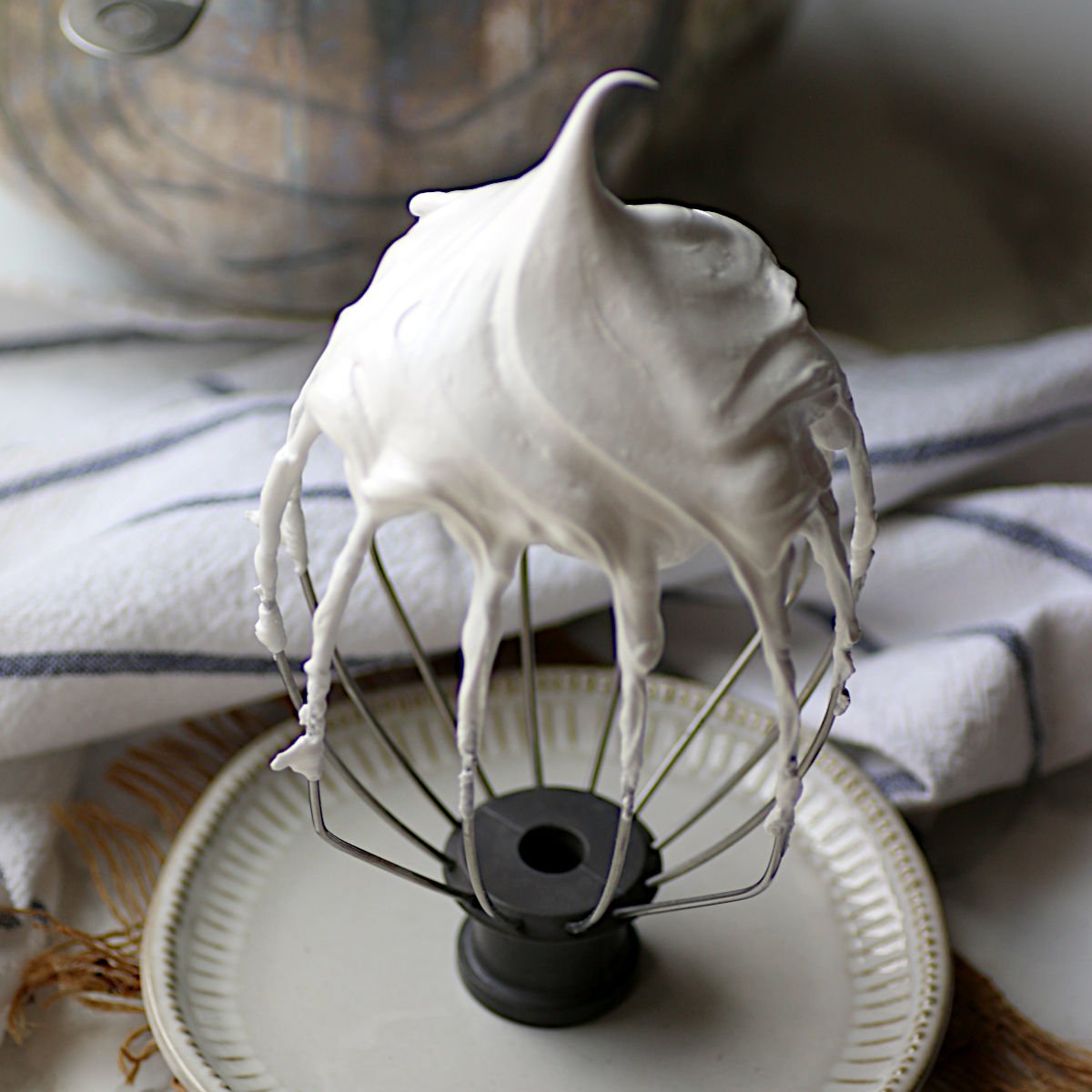Italian Meringue
Italian Meringue is a thick, fluffy, marshmallowy meringue that doesn’t need to be cooked after it’s made. Use it as a frosting or topping for desserts.
When I was growing up, 7-Minute Icing (also known as 7-Minute Frosting or Boiled Icing) was my absolute favorite frosting for cakes. Someone submitted their recipe for it in our community cookbook, and that page of our copy became stained and tattered from using the recipe so often.
I still love the sweet, marshmallow-like frosting on cakes, but I only recently learned that my favorite frosting is the same as Italian Meringue.
What’s the difference between Italian Meringue and Marshmallow Fluff?
The main difference between Italian Meringue and Marshmallow Fluff (or marshmallow creme) is that Marshmallow Fluff contains corn syrup for even more stability.
Marshmallow fluff has a stiffer texture and is stickier and more difficult to spread. In my experience, it may also be more likely to contain more vanilla to replicate the “marshmallow” flavor.
Use Italian Meringue for frosting cakes and cupcakes, and topping pies and squares. Use Marshmallow Fluff for swirling into brownies, or using as a spread to make fluffernutter sandwiches or s’mores and s’mores-inspired desserts.
What can I use Italian Meringue for?
You can use Italian Meringue as a topping for pies, tarts or squares, in lieu of the more common French meringue that is often used. I used it to top Strawberry Rhubarb Meringue Squares recently.
You can also use it as a frosting and/or filling for cakes, as it is the same thing as “Boiled Icing” or “Boiled Frosting” or “7 Minute Frosting”. It is especially delicious on angel food cake and chocolate cake.

How to make Italian Meringue
Making Italian Meringue is only a little more difficult than making French meringue, which is considered the easiest type of meringue to make. However, the upside is that Italian Meringue does not need to be cooked after it’s made, which means it can safely be used as a frosting or topping for desserts that don’t need to be or can’t be heated (think ice cream).
Start by adding some water and sugar to a small saucepan, making sure that the sugar remains in the center of the pot and doesn’t adhere to the sides. Attach a candy thermometer to the side of the pot, or get an instant-read thermometer ready. Heat over high heat and stir until the sugar is dissolved, then monitor the temperature without stirring until the mixture reaches 240°F.
Meanwhile, add the egg whites and cream of tartar to the bowl of a stand mixer. Make sure that none of the egg whites contain any yolk, and that both the bowl or the whisk attachment are free of any greasy residue. Both of these will affect the ability of the egg whites to whip up and remain stable.
Whip the egg whites at medium-high speed until they form soft peaks. Stop mixing for now until the syrup is ready. Once the syrup reaches 240°F, turn the mixer on medium again, and slowly pour the syrup into the bowl containing the egg whites (do this carefully, and ideally close to the side of the bowl to reduce the chances of the syrup hitting the whisk and getting flung everywhere).
Increase the mixer speed to medium-high, and continue mixing until the meringue becomes thick and glossy white, holds stiff peaks and the bottom of the bowl feels warm, not hot. Add the vanilla and mix for another 30-60 seconds. Leftovers can be stored in an airtight container in the fridge for up to 3 days. You might need to give it a whip before using if it has deflated slightly.
Can I toast my Italian Meringue?
Yes! You can toast your Meringue as a final step once you have it covering your cake, pie, or whatever you’re using it on. Toasting it gives it both a browned appearance and a toasted marshmallow flavor.
You can use either the broiler in your oven or a kitchen torch. The broiler gives you a more even golden brown look, but can easily ruin the entire dessert if you leave it in too long. A kitchen torch gives you more control and results in darker, more localized browning.
However you toast your meringue, make sure you do it carefully and keep your eyes on it the whole time as it can burn very quickly.
To toast it under the broiler, turn the broiler on low, and place your dessert on a higher rack in the oven (you want the dessert to be about 4-6 inches away from the broiler element or top of the oven). Broil for 2-3 minutes, or until the meringue is as browned as you want it. Be ready to remove the dessert immediately once it’s done.
Alternatively, use a kitchen torch, keeping the flame an inch or two away from the meringue. Torch all over the outside of the dessert until it’s as toasted as you want it.

Italian Meringue Ingredients
- Water – use whatever water you normally drink. Tap water is fine.
- Granulated sugar
- Large egg whites – the egg whites need to be entirely free of yolk to whip properly. Crack the eggs one at a time to avoid contaminating them all if a yolk does happen to break.
- Cream of tartar – Cream of tartar is a powdered acid that helps to stabilize whipped egg whites. Find it in the baking aisle, usually with the spices.
- Vanilla extract or other flavoring of your choice

Want more meringue recipes?
Italian Meringue Nutrition Notes
The calories in Italian Meringue come mostly from the sugar in it, but compared to most other frostings (like buttercream), it is essentially fat-free and much lower in calories.
The nutrition information in the recipe below is for approximately 1 cup of the meringue, which is a very large portion.
This recipe is dairy-free and gluten-free as written.
Equipment
Ingredients
Instructions
- Add 6 Tablespoons water to a small saucepan. Carefully pour 3/4 cups granulated sugar into the center of the saucepan, ensuring that none of it touches the sides of the pot. If using a candy thermometer, attach it to the side of the saucepan now. Turn the heat on high, and carefully stir until the sugar is dissolved and the mixture starts to boil. Once it starts to boil, stop stirring, and keep an eye on the temperature. Cook the mixture until the temperature reaches 240℉.
- While you're waiting for the syrup, add 3 large egg whites and 1/2 teaspoon cream of tartar to the bowl of a stand mixer that is fitted with a whisk attachment. Turn the mixer on medium speed until the egg whites are frothy, then turn the mixer on medium-high speed until the egg whites form soft peaks. Turn the mixer off until the sugar syrup is ready.
- Once the syrup reaches 240°F, turn the mixer back on medium speed and very carefully drizzle the hot syrup into the mixer bowl (try to do this at the very side of the bowl so that the syrup doesn't hit the whisk and get flung everywhere). Once all of the syrup has been added, turn the mixer back up to medium-high speed and continue to mix until the mixture forms stiff peaks. Add 1/2 teaspoon vanilla extract and mix until incorporated, about 30 more seconds. Use as desired as a meringue topping or cake frosting. Refrigerate any leftovers in an airtight container for up to 3 days.
Nutrition
Notes
Tried this recipe?
Please Consider Leaving a Review!




